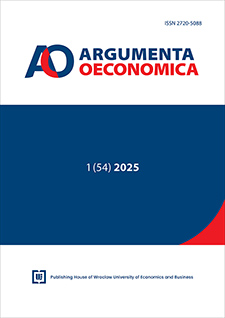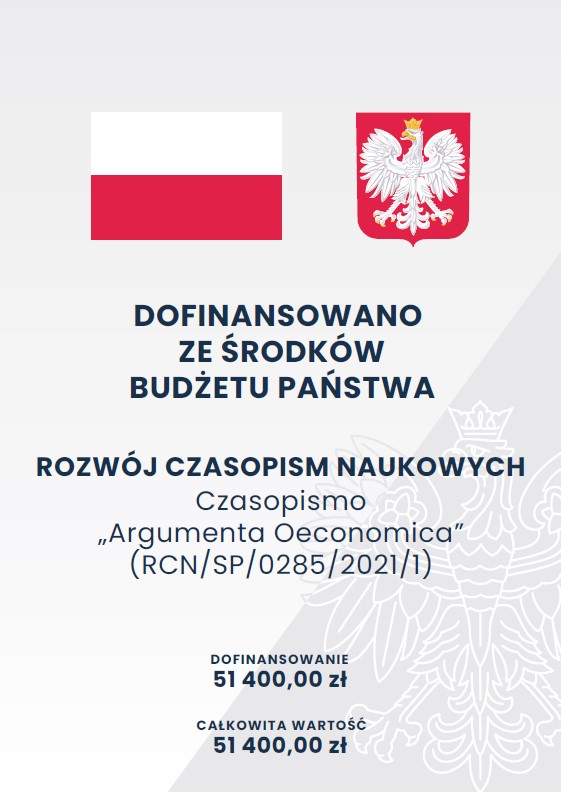Implications of behavioural economics for public regulation: An experimental study among officials of regulatory bodies in Poland
DOI:
https://doi.org/10.15611/aoe.2025.1.03Keywords:
regulation, heuristics, cognitive biases, prospect theory, behavioural economicsAbstract
Aim: Identification and determination of the importance of behavioural factors in public regulation. The study also delved into whether officials working in public regulatory bodies exhibit behavioural patterns similar to those of non-officials when making regulatory decisions.
Methodology: The author used the results from experimental studies conducted among officials from regulatory bodies in Poland, specifically the Office of Electronic Communications (OEC, n = 107) and the Energy Regulatory Office (ERO, n = 157). A control group comprised non-officials (Non-officials, n = 102). The research was conducted during the transition between 2022 and 2023.
Results: The findings revealed that officials in public regulatory bodies (regulators) overseeing network sectors in Poland are not free from behavioural influences. These include the certainty effect – leading to risk aversion (positive prospect), loss avoidance effect – causing risk-seeking behaviour (negative prospect) and the reflection effect in line with prospect theory. Additionally, they demonstrated the risk aversion effect stemming from the tendency to overestimate losses and underestimate gains, uncertainty effect, status quo effect, anchoring heuristic – the effect of asymmetric domination and the better-than-average effect, calibration effect and overconfidence effect, however, the prevalence of these effects varied. Furthermore, statistically significant differences in the occurrence of these behavioural effects were observed between officials of various regulatory bodies and the Non-experts group (78.6% of cases), which were more pronounced than the differences between the regulatory bodies themselves (21.4% of cases).
Implications and recommendations: The research results underline the necessity of augmenting the conventional approach to regulation with an understanding of the behavioural factors that influence regulatory decision-making. Further research and the replication of the article’s findings are necessary, primarily due to the limitations of the research results. The experiments provided an opportunity to test the behavioural effects but they did not explore their relationship with the personality traits of the subjects. This aspect will be the focus of analysis in the forthcoming article. Additionally, future experiments may uncover other behavioural effects.
Originality/value: The conclusions presented in this article contribute a unique perspective to the discourse on public regulation, drawing from empirical research results. This presents findings from a study involving officials from two distinct regulatory bodies. The novelty of research into the behavioural determinants of decisions made by officials in regulatory bodies expands the realm of regulatory research. This could potentially open new avenues for resolving regulatory dilemmas.
Downloads
References
Almlöf, H., & Bjuggren, P.-O. (2019). A regulation and transaction cost perspective on the design of corporate law. European Journal of Law and Economics, 47(3), 407-433.
Bateman, I. J., Munro, A., & Poe, G. L. (2008). Decoy effects in choice experiments and contingent valuation: Asymmetric dominance. Land Economics, 84(1), 115-127.
Battaglio, R.cP., Belardinelli, P., Bellé, N., & Cantarelli, P. (2019). Behavioral Public administration ad fontes: A synthesis of research on bounded rationality, cognitive biases, and nudging in public organization. Public Administration Review, 79(3), 304-320.
Bellé, N., Cantarelli, P., & Belardinelli, P. (2018). Prospect theory goes public: Experimental evidence on cognitive biases in public policy and management decisions. Public Administration Review, 78(6), 828-840.
Benoît, C. (2019). The new political economy of regulation. French Politics, 17(4), 482-499.
Busuioc, M., & Lodge, M. (2017). Reputation and accountability relationships: Managing accountability expectations through reputation. Public Administration Review, 77(1), 91-100.
Cantarelli, P., Bellé, N., & Belardinelli, P. (2020). Behavioral Public HR: Experimental evidence on cognitive biases and debiasing interventions. Review of Public Personnel Administration, 40(1), 56-81.
Carrigan, C., & Coglianese, C. (2015). George Stigler, the theory of economic regulation. In M. Lodge, E. Page, S. Balla, (Eds.), The Oxford Handbook of Classics in Public Policy and Administration (pp. 287-299). Oxford University Press.
Cave, M., Genakos, Ch., & Valletti, T. (2019). The European framework for regulating telecommunications: A 25‑year appraisal. Review of Industrial Organization, 55(1), 47-62.
Christensen, J. (2011). Competing theories of regulatory governance: reconsidering public interest theory of regulation. In D. Levi-Faur (Ed.), Handbook on the Politics of Regulation. Edward Elgar.
Coletti, P., & Radaelli, C. (2013). Economic rationales, learning, and regulatory policy instruments. Public Administration, 91(4), 1056-1070.
Cooper, J. C., & Kovacic, W. E. (2012). Behavioral economics: implications for regulatory behavior. Journal of Regulation Economics, 41(1), 51-52.
Debbichia, S. & Slama, R. B. (2022). Impact of regulatory process on telecom firm performance: Evidence from non parametric approach. Quantitative Economics and Management Studies, 3(1), 44-57.
Dudley, S. E., & Xie Z. (2022). Nudging the nudger: Toward a choice architecture for regulators. Regulation & Governance, 16(1), 261-273.
Dziadkiewicz, M., & Cichowski, P. (2020). Real estate management against state policy regarding the development of the fiber optic network. Ekonomia i Prawo. Economics and Law, 19(3), 467-478.
Embrey, I. P. (2020). States of nature and states of mind: A generalized theory of decision-making. Theory and Decision, 88(1), 5-35.
Fremeth, A. R., & Holburn, G. L. F. (2010). Information asymmetries and regulatory decision costs: An analysis of U.S. electric utility rate changes 1980–2000. Journal of Law, Economics, and Organization, 28(1), 127-162.
Genakos, C., & Valletti T. (2015). Evaluating a decade of mobile termination rate regulation. Economic Journal, 125(586), 31-48.
Genakos, C., Verboven, F., & Valletti, T. (2018). Evaluating market consolidation in mobile communications. Economic Policy, 33(93), 45-100.
González, C. I., & Verhoest, K. (2020). De facto regulatory decision-making processes in telecommunications regulation: Explaining influence relationships with exponential random graph models. Journal of Public Policy, 40(1), 144-170.
Grajek, M., & Roller, L.-H. (2012). Regulation and investment in network industries: Evidence from European telecoms. Journal of Law and Economics, 55(1), 189-216.
Grimmelikhuijsen, S., Jilke, S., Olsen, A., & Tummers, L. (2017). Behavioral public administration: Combining insights from public administration and psychology. Public Administration Review, 77, 45-56.
Hanretty, C., & Koop, C. (2018). Political independence, accountability, and the quality of regulatory decisionmaking. Comparative Political Studies, 51(1), 38-75.
Hantke-Domas, M. (2003). The public interest theory of regulation: Non–existence or misinterpretation? European Journal of Law and Economics, 15(2), 165-194.
Hertog, J. (2010). Review of economic theories of regulation. Tjalling C. Koopmans Research Institute, Utrecht School of Economics, Utrecht University.
Kahneman, D., & Tversky, A. (1979). Prospect theory: An analysis of decisions under risk. Econometrica, 47, 313-327.
Koop, C., & Lodge M. (2017). What is regulation? An interdisciplinary concept analysis. Regulation & Governance, 11(1), 95-108.
Iborra, S. S., Saz-Carranza, A., Fernández-i-Marín, X., & Albareda, A. (2017). The governance of goal–directed networks and network tasks: An empirical analysis of European regulatory networks. Journal of Public Administration Research and Theory, 28(2), 270-292.
Laffont, J.-J., & Tirole, J. (1991). The politics of government decision–making: A theory of regulatory capture. The Quarterly Journal of Economics, 106(4), 1089-1127.
Li, Y., & Lyons, B. (2012). Market structure, regulation and the speed of mobile network penetration. International Journal of Industrial Organization, 30(6), 697-707.
Maggetti, M., & Papadopoulos, Y. (2018). The principal–agent framework and independent regulatory agencies. Political Studies Review, 16(3), 172-183.
Marjosola, H. (2021). The problem of regulatory arbitrage: A transaction cost economics perspective. Regulation & Governance, 15(2), 388-407.
Mathieu, E. (2016). When Europeanization feeds back into EU governance: EU legislation, national regulatory agencies, and EU regulatory networks. Public Administration, 94(1), 25-39.
Maziarz, W. M. (2015). Strategiczne aspekty funkcjonowania operatorów na rynku usług telefonii komórkowej w Polsce. Firma i Rynek, 1(48), 33-44.
Mizutani, F., & Nakamura, E. (2019). Regulation, public interest, and private interest: An empirical investigation of firms in Japan. Empirical Economics, 56(4), 1433-1454.
Nagaj, R., & Szkudlarek, P. (2012a). Regulacja na rzecz konkurencji w wybranych sektorach sieciowych. Ekonomia, 2(19), 70-86.
Nagaj, R., & Szkudlarek, P. (2012b). Regulacja na rynkach sieciowych w Polsce w kontekście ekonomii dobrobytu. Studia Ekonomiczne, 102, 205-213.
Nardotto, M., Valletti, T., & Verboven, F. (2015). Unbundling the incumbent: Evidence from the UK broadband. Journal of the European Economic Association, 13(2), 330-362.
Peltzman, S. (1989). The Economic Theory of Regulation after a Decade of Deregulation. University of Chicago.
Petrażycki, L. (1959). Wstęp do nauki prawa i moralności. Podstawy psychologii emocjonalnej. Państwowe Wydawnictwo Naukowe.
Posner, R. A. (1971). Taxation by regulation. The Bell Journal of Economics, 2(1), 22-50.
Posner, R. A. (1974). Theories of economic regulation. The Bell Journal of Economics and Management Science, 5(2), 335-358.
Rajabiun, R., & Middleton, C. (2015). Public interest in the regulation of competition: Evidence from wholesale internet access consultations in Canada. Journal of Information Policy, 5, 32-66.
Roberts, P. S., & Wernstedt, K. (2019). Decision biases and heuristics among emergency managers: Just like the public they manage for? The American Review of Public Administration, 49(3), 292-308.
Russo, J. E., & Schoemaker, P. J. H. (1992). Managing overconfidence. Sloan Management Review, 33(2), 7-17.
Saz–Carranza, A., Albareda, A., & Federo, R. (2020). Network tasks and accountability: A configurational analysis of EU regulatory networks. Public Administration, 98(2), 480-497.
Scheerlinck, G., Buts, C., Reniers, G., & Cools, M. (2017). Law in action in the private security industry: The impact of regulation on competition. European Competition and Regulatory Law Review, 1(2), 96-114.
Schillemans, T. (2022). Accountability and the quality of regulatory judgment processes. Experimental research offering both confirmation and consolation. Public Performance & Management Review, 45(3), 473-498.
Sheffer, L., Loewen, P. J., Soroka, S., Walgrave, S., & Sheafer, T. (2018). Nonrepresentative representatives: An experimental study of the decision making of elected politicians. American Political Science Review, 112(2), 302-321.
Sherman, R. (2001). The future of market regulation. Southern Economic Journal, 67(4), 782-800.
Shortall, T., & Cave, M. (2015). Is symmetric access regulation a policy choice? Evidence from the deployment of NGA in Europe. Communications and Strategie, 1(98), 17-41.
Spiller, P. T. (2013). Transaction cost of regulation. Journal of Economic Behavior & Organization, 89(C), 232-242.
Spulber, D. F. (1989). Regulation and Markets. MIT Press.
Stigler, G. (1971). The theory of economic regulation. The Bell Journal of Economics and Management Sciences, 2(1), 3-21.
Stiglitz, J. E. (2000). The contributions of the economics of information to twentieth century economics. Quarterly Journal of Economics, 115(4), 1441-1478.
Szkudlarek, P. (2016). Rynek usług telekomunikacyjnych w Polsce w kontekście budowy potencjału gospodarczego. Studia Ekonomiczne, 286, 165-174.
Szkudlarek, P. (2017). Regulacja rynku – ujęcie behawioralne. Studia i Prace Wydziału Nauk Ekonomicznych i Zarządzania, 47(1), 57-68.
Szkudlarek, P. (2020). Regulatory decisions in the context of risk and uncertainty. Prace Naukowe Uniwersytetu Ekonomicznego we Wrocławiu, 64(10), 107-117.
Szkudlarek, P. (2021). Choice preferences in the process of making regulatory decisions under risk and uncertainty conditions: an experimental study. European Research Studies Journal, XXIV(2B), 1127-1141.
Szkudlarek, P. (2022). Regulacja z perspektywy ekonomii instytucjonalnej i ekonomii behawioralnej na przykładzie rynku usług telekomunikacyjnych w Polsce. Wydawnictwo Naukowe Uniwersytetu Szczecińskiego.
Szydło, M. (2005). Regulacja sektorów infrastrukturalnych jako rodzaj funkcji państwa wobec gospodarki. Wydawnictwo Prawo i Praktyka Gospodarcza.
Szyszka, A. (2009). Finanse behawioralne. Nowe podejście do inwestowania na rynku kapitałowym. Wydawnictwo Uniwersytetu Ekonomicznego w Poznaniu.
Tasic, S. (2009). The illusion of regulatory competence. Critical Review, 21(4), 423-436.
Tasic, S. (2011). Are regulators rational? Journal des Economistes et des Etudes Humaines, 17(1), 1-21.
Veljanovski, C. (2010). Economic approaches to regulation. In R. Baldwin, M. Cave, & M. Lodge (Eds.), The Oxford Handbook of Regulation Oxford University Press, 17-38. Viscusi, W. K., Harrington, J. E., & Vernon, J. M. (2005). Economics of Regulation and Antitrust. The MIT Press.
Viscusi, W. K., & Gayer, T. (2015). Behavioral Public Choice: The Behavioral Paradox of Government Policy. Harvard Journal of Law and Public Policy, 38(3), 973-1007.
Weisman, D. L. (2019). The power of regulatory regimes reexamined. Journal of Regulatory Economics, 56(2), 125-148.
Zyzik, R. (2021). Behawioralna analiza prawa. Wydawnictwo Naukowe Akademii Ignatianum w Krakowie.
Downloads
Published
License
Copyright (c) 2025 Piotr Szkudlarek

This work is licensed under a Creative Commons Attribution-ShareAlike 4.0 International License.
Accepted 2024-09-17
Published 2025-02-11








